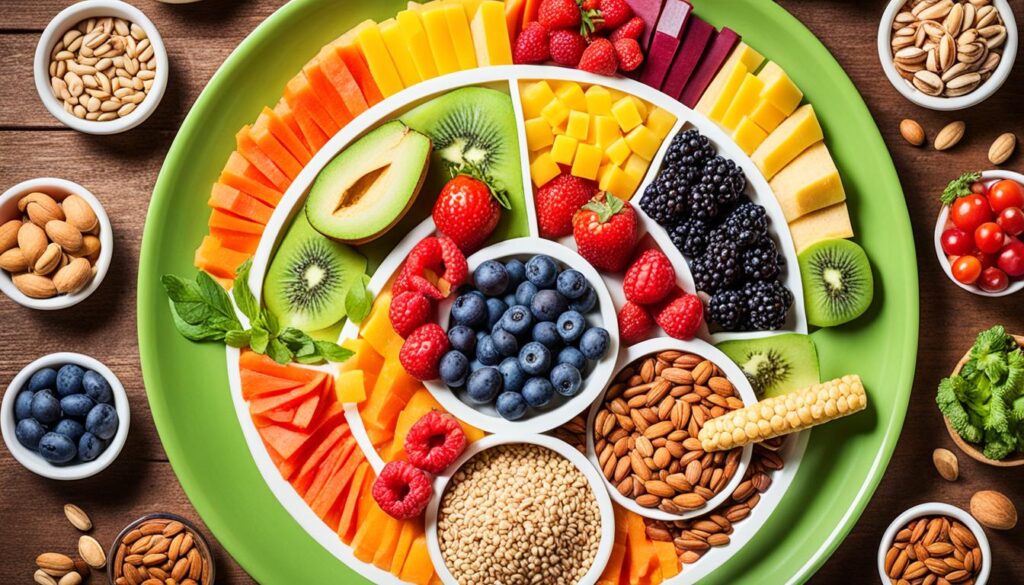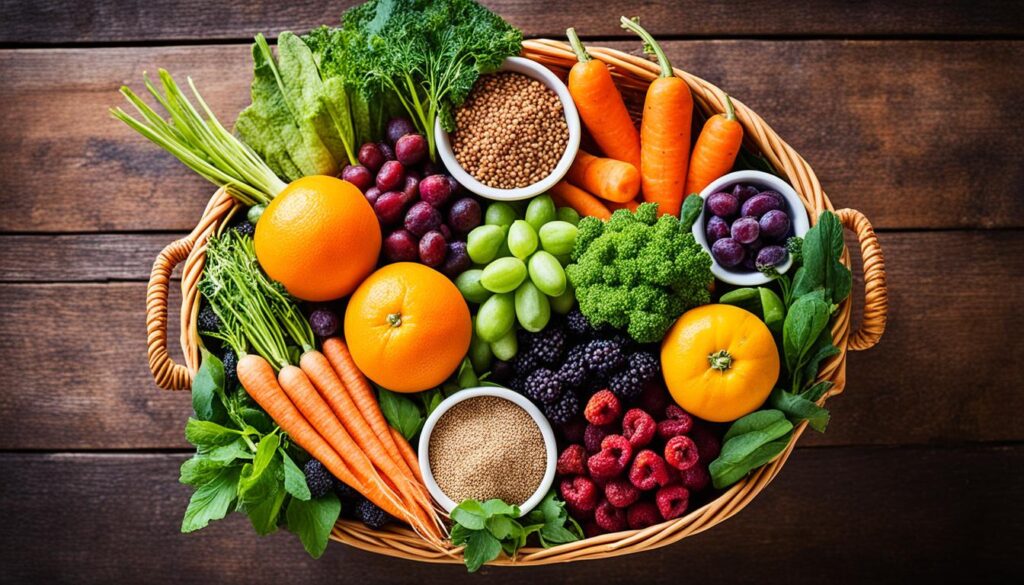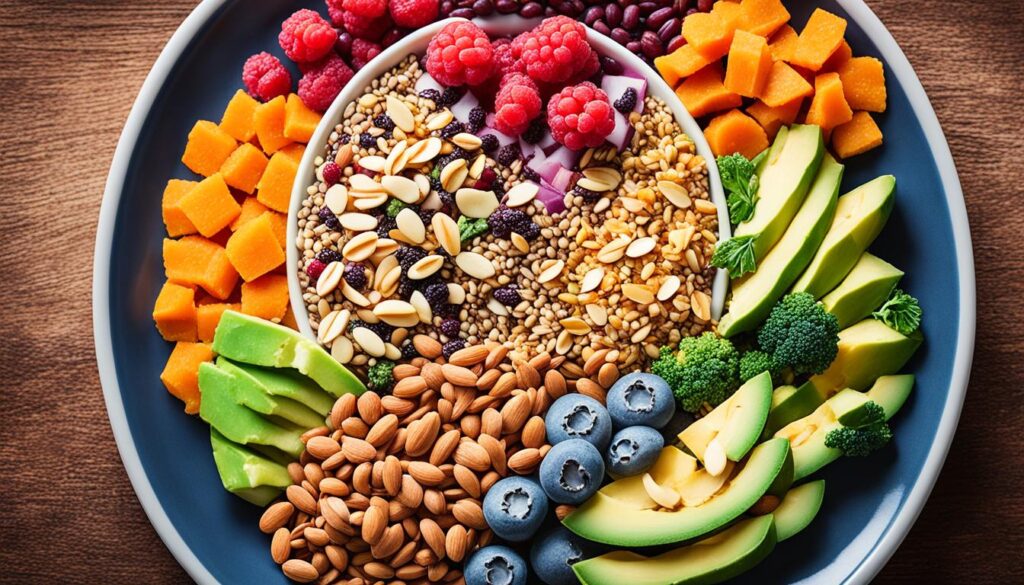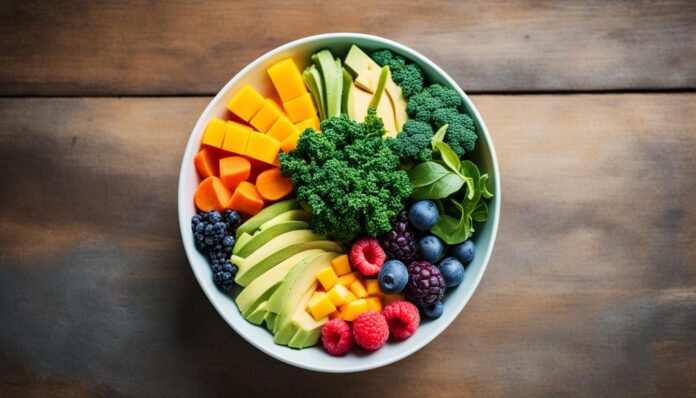Are you aware that the average American adult consumes only half the recommended daily amount of dietary fiber1? Yet, fiber is a crucial component of a healthy, balanced diet. So, how can you make sure you’re getting enough fiber, and what are the benefits? Discover the answers in this comprehensive guide to fiber’s role in your diet.
Key Takeaways
- Dietary fiber provides numerous health benefits, including normalizing bowel movements, maintaining bowel health, and lowering cholesterol levels.
- Soluble fiber can help lower blood cholesterol and glucose levels, while insoluble fiber facilitates digestion and increases stool bulk2.
- The recommended daily fiber intake is 38 grams for men under 50, 30 grams for men over 50, 25 grams for women under 50, and 21 grams for women over 502.
- Increasing fiber intake, particularly from whole foods, can reduce the risk of cardiovascular disease and certain cancers2.
- High-fiber foods are more filling and can aid in achieving and maintaining a healthy weight2.
What is Dietary Fiber?
Dietary fiber, often referred to as roughage or bulk, comprises the parts of plant foods that the human body cannot digest or absorb3. This essential nutrient is commonly classified into two main types: soluble fiber and insoluble fiber.
Soluble Fiber and Insoluble Fiber
Soluble fiber, found in foods like oats, peas, beans, apples, citrus fruits, carrots, and barley, dissolves in water3. This type of fiber can help lower blood cholesterol and glucose levels3. Insoluble fiber, on the other hand, does not dissolve in water and is found in whole-wheat flour, wheat bran, nuts, beans, and vegetables3. Insoluble fiber promotes the movement of material through the digestive system and increases stool bulk.
Dietary fiber plays a crucial role in maintaining overall health4. However, the majority of Americans only consume around 15 grams of fiber per day, far below the recommended 25 to 35 grams per day4. Increasing your intake of various fiber-rich foods can provide a range of benefits, from reducing the risk of heart disease and diabetes to improving digestive health4.
Dietary fibers can be further classified into naturally occurring plant fibers, such as cellulose, hemicellulose, lignins, beta-glucans, and pectins, as well as manufactured functional fibers extracted and modified from natural sources, including psyllium, polydextrose, and resistant starch4. Consuming a diverse array of fiber-rich foods is recommended to ensure maximum health benefits4.
“Fiber can lower the risk of developing conditions such as heart disease, diabetes, diverticular disease, and constipation.”4
The Role of Fiber in Your Diet and How to Increase Intake
Dietary fiber is a crucial component of a healthy and balanced diet. It plays a vital role in maintaining overall wellness, from regulating bowel movements to lowering cholesterol levels5. In fact, it is recommended that women aim for 25 grams of fiber daily and men 38 grams5. Unfortunately, most Americans only consume around 16 grams of fiber per day, falling short of the recommended amount5.
Increasing your intake of high-fiber foods can provide a wealth of benefits. Non-starchy vegetables, in particular, are low in calories yet high in fiber and other essential nutrients5. Incorporating more of these nutrient-dense options, such as salads or vegetable soups, into your meals can help you feel fuller and consume fewer calories overall5.
Whole grains, fruits, and legumes are also excellent sources of fiber. Popcorn, a whole grain, can provide 4 grams of fiber per ounce5. High-fiber fruits like pears, apples, and berries are readily available and easy to incorporate into your diet5. Beans, lentils, and other legumes are rich in fiber, protein, carbohydrates, vitamins, and minerals5.
Nuts and seeds can also boost your fiber intake. Chia seeds, for example, contain about 10 grams of fiber per ounce, with up to 93% being insoluble fiber5. Half an avocado delivers 5 grams of fiber5, while an ounce of almonds has close to 4 grams5. A cup of raspberries or blackberries can provide 8 grams of fiber5.
To increase your fiber intake, focus on consuming a variety of whole, fiber-rich foods throughout the day. By making small, gradual changes to your diet, you can reap the numerous health benefits that a high-fiber lifestyle can provide6.
| Food | Fiber Content |
|---|---|
| 1 medium apple with peel | 4.4 grams7 |
| 1/2 cup applesauce | 1.4 grams7 |
| 4 ounces apple juice | 0 grams7 |
| 1 large pear with skin | 7 grams7 |
| 1 cup fresh raspberries | 8 grams7 |
| 1/2 medium avocado | 5 grams7 |
| 1 ounce almonds | 3.5 grams7 |
| 1/2 cup cooked black beans | 7.5 grams7 |
| 3 cups air-popped popcorn | 3.6 grams7 |
| 1 cup cooked pearled barley | 6 grams7 |
“Dietary fiber intake of 30 grams per day is recommended for optimal health.”6
By focusing on a variety of high-fiber foods, you can easily boost your overall fiber intake and enjoy the countless benefits it provides. Remember to stay hydrated when increasing your fiber consumption to prevent any potential discomfort6.
Benefits of a High-Fiber Diet
A diet rich in dietary fiber offers numerous health benefits. Fiber plays a crucial role in supporting overall well-being, from maintaining regular bowel movements to lowering cholesterol levels8910.
Normalizes Bowel Movements
Fiber increases the weight and size of stool, making it easier to pass and decreasing the likelihood of constipation9. By adding bulk to the digestive tract, fiber helps waste move more efficiently through the body, promoting regular and healthy bowel movements9.
Helps Maintain Bowel Health
A high-fiber diet may help reduce the risk of developing hemorrhoids and small pouches in the colon (diverticular disease)9. Additionally, studies have found that a diet high in fiber may lower the risk of colorectal cancer9.
Lowers Cholesterol Levels
Soluble fiber, found in foods like beans, oats, flaxseed, and oat bran, can help lower total blood cholesterol levels by reducing low-density lipoprotein (LDL), or “bad,” cholesterol910. Incorporating more of these fiber-rich foods into your diet can contribute to better heart health.
“Increasing fiber intake is associated with a 45% reduction in the risk of premature death in adults with diabetes.”10
Overall, a diet rich in fiber provides a range of benefits, from regulating bowel function to supporting cardiovascular health. Incorporating more fiber-rich foods into your daily meals and snacks can be a simple yet effective way to improve your overall well-being8910.
Recommended Daily Fiber Intake
The recommended daily fiber intake varies based on age and gender. According to the Institute of Medicine, adults should consume 38 grams of fiber per day if they are men aged 50 or younger, and 30 grams if they are men aged 51 or older11. For women, the recommendations are 25 grams per day for those aged 50 or younger, and 21 grams for those aged 51 or older11. However, the average American only consumes around 16 grams of fiber per day, which is significantly less than the recommended amounts11.
The Dietary Guidelines for Americans suggest different fiber intake levels based on age and sex, with amounts varying from 22 to 34 grams per day11. Children aged 1 to 18 should consume between 14 to 31 grams of fiber daily, depending on their age and sex11. Fiber intake in higher quantities, as seen in various countries globally, has been found to correlate with a reduced risk of chronic diseases11.
Fiber intake supports various health benefits, including weight loss, cholesterol reduction, decreased risk of cardiovascular diseases, diabetes, colorectal and breast cancer, improved digestive health, and balanced gut bacteria11. Soluble fiber aids in lowering cholesterol and blood sugar levels, while insoluble fiber adds bulk to stool, aiding regular bowel movements11.
While there is no daily upper limit for fiber intake, excessive consumption may lead to symptoms such as gas, bloating, constipation, diarrhea, abdominal cramping, and in rare cases, bowel obstruction11. To avoid these issues, it is recommended to gradually increase fiber intake and ensure adequate water intake11.

Ultimately, the goal is to consume a diverse range of fiber-rich foods to promote overall health and well-being12. By making fiber-rich choices, such as whole grains, fruits, vegetables, legumes, nuts, and seeds, individuals can easily meet their daily fiber requirements and enjoy the numerous benefits of a high-fiber diet13.
| Food | Fiber Content (per 100g) |
|---|---|
| White Beans | 9.9 grams |
| Chickpeas | 8.8 grams |
| Almonds | 10.2 grams |
| Flaxseeds | 34.8 grams |
| Kale | 4.7 grams |
By incorporating a variety of fiber-rich foods into your diet, you can easily meet the recommended daily fiber intake and enjoy the many health benefits that come with it12.
“Fiber is essential for maintaining a healthy digestive system and promoting overall well-being. Aim to consume a diverse range of fiber-rich foods to meet your daily needs.”
Fiber-Rich Food Sources
Boosting your fiber intake is easy when you focus on consuming a variety of whole grains, fruits, vegetables, legumes, nuts, and seeds. These high-fiber foods and fiber-rich sources can help you meet your daily fiber needs and support overall health14.
Whole Grains and Cereals
Whole-grain breads, cereals, and pasta are excellent sources of fiber in grains. Opt for options like oats, barley, and brown rice to maximize your fiber intake14. Whole-wheat spaghetti, for instance, provides 6.0 grams of fiber per cup, while bran flakes offer 5.5 grams per 3/4 cup15.
Fruits and Vegetables
Fruits and vegetables are powerhouses of fiber in fruits and veggies. Raspberries, with 8.0 grams of fiber per cup, and green peas, boasting 9.0 grams per cup, are just a few examples of fiber-rich produce choices15. Broccoli (2.6 grams per 100 grams), pears (6.0 grams per medium fruit), and blackberries (7.5 grams per cup) also contribute significant amounts of fiber to your diet16.
Legumes, Nuts, and Seeds
Fiber in legumes is particularly abundant. A cup of kidney beans provides around one-third or more of the daily fiber requirement14, while lentils and split peas offer 18 grams and 16 grams of fiber per cup, respectively16. Nuts and seeds, such as almonds (3.5 grams per ounce) and chia seeds (10.0 grams per ounce), are also excellent fiber-rich sources15.
By incorporating a variety of these high-fiber foods into your meals and snacks, you can easily boost your daily fiber intake and support your overall health and well-being14.
| Food Item | Fiber Content (per 100g) |
|---|---|
| Avocado | 6.7 grams |
| Oats | 10.1 grams |
| Raspberries | 6.5 grams |
| Lentils | 10.7 grams |
| Split Peas | 8.3 grams |
| Quinoa | 2.8 grams |
| Popcorn | 14.5 grams |
| Almonds | 13.3 grams |
Incorporating More Fiber into Your Diet
Fiber-Boosting Tips for Meals and Snacks
Incorporating more fiber into your daily routine is an effective way to support your overall health and well-being. Start your day with a high-fiber breakfast by choosing a whole-grain cereal or adding unprocessed wheat bran to your favorite cereal17. Switch to whole-grain breads, pastas, and rice, and explore other nutrient-dense whole grains like barley and bulgur18.
Legumes, such as beans, peas, and lentils, are excellent sources of fiber. Add them to soups, salads, and main dishes to boost your fiber intake17. Snack on fresh fruits, raw vegetables, popcorn, or a handful of nuts or dried fruit to satisfy your cravings while also getting a fiber boost18.
Gradually increasing your fiber intake can help your digestive system adjust to the changes19. By making simple swaps and incorporating fiber-rich foods throughout the day, you can easily increase your fiber intake and enjoy the numerous health benefits it provides.

“Increasing your fiber intake can be a game-changer for your overall health, from promoting regular bowel movements to supporting cardiovascular health.”
Remember, it’s important to stay hydrated when consuming a high-fiber diet to help your digestive system function optimally. Drink plenty of water throughout the day to support your fiber-rich meals and snacks171819.
The Importance of Soluble Fiber
Fiber plays a crucial role in maintaining overall health, and soluble fiber, in particular, offers a range of benefits20. Soluble fiber, which dissolves in water, has been shown to reduce total blood cholesterol levels and may improve blood sugar levels in people with diabetes21. In fact, soluble fiber slows down digestion, aiding in lowering fat absorption, stabilizing blood sugar levels, reducing the risk of cardiovascular disease, and feeding healthy gut bacteria21.
The best sources of soluble fiber are oats, dried beans, apples, citrus fruits, and barley20. Many experts recommend that about one-fourth of your total daily fiber intake, or 6 to 8 grams, should come from soluble fiber20. This is important because22 the average American only gets about half of the recommended daily fiber intake, which varies by age and gender22.
Incorporating more soluble fiber into your diet can have significant benefits for your overall health. Soluble fiber can help normalize bowel movements, maintain bowel health, and lower cholesterol levels20. By focusing on foods rich in soluble fiber, you can ensure that you’re meeting your daily fiber needs and reaping the associated health rewards.
Achieving the recommended daily intake of fiber, with a focus on soluble fiber, can have a profound impact on your well-being202122. Whether you choose to consume soluble fiber through whole foods or supplements, the key is to gradually increase your intake and stay hydrated to ensure a smooth transition and maximum health benefits.
“Dietary fiber recommendations emphasize eating a variety of fruits, vegetables, legumes, and grains to meet the daily fiber intake.”20
Fiber Supplements and Fortified Foods
While whole, fiber-rich foods are generally the best source of dietary fiber, some individuals may benefit from fiber supplements or fiber-fortified foods to help meet their daily fiber needs23. Fiber supplements, such as Metamucil, Citrucel, and FiberCon, can provide an additional boost of fiber, although they do not offer the same variety of nutrients as whole foods23.
Another way to increase fiber intake is to consume foods that have been fortified with fiber. These can include cereals, granola bars, yogurt, and even ice cream, which often contain added inulin or chicory root as a source of fiber23. Research suggests that a higher intake of fiber, whether from whole foods or fiber-fortified products, can offer a range of health benefits, including weight management, cholesterol reduction, and a lower risk of chronic diseases24.
| Fiber-Fortified Food | Fiber Content per Serving |
|---|---|
| Fiber-Fortified Cereal | 5-14 grams |
| Fiber-Fortified Granola Bar | 3-5 grams |
| Fiber-Fortified Yogurt | 2-4 grams |
| Fiber-Fortified Ice Cream | 2-3 grams |
It’s important to note that while fiber supplements and fortified foods can be a convenient way to boost fiber intake, they should not replace the consumption of whole, fiber-rich foods25. Consuming more than 50 grams of fiber per day can potentially interfere with nutrient absorption and lead to digestive issues, such as gas, bloating, and cramping25.
“Fiber supplements can be a helpful addition to a high-fiber diet, but they should not be viewed as a replacement for whole, fiber-rich foods. The variety of nutrients found in fruits, vegetables, whole grains, and legumes is essential for overall health.”
When incorporating fiber supplements or fortified foods into your diet, it’s crucial to do so gradually and in moderation, while also prioritizing the consumption of a variety of whole, fiber-rich foods. This balanced approach can help you reap the full benefits of a high-fiber diet without any adverse effects25.
Increasing Fiber Gradually
When it comes to boosting your fiber intake, a gradual approach is key. Adding too much fiber too quickly can lead to unpleasant side effects like intestinal gas, abdominal bloating, and cramping26. The recommended guideline is to increase your fiber intake by 2 to 3 grams per day over a few weeks to allow your digestive system to adjust26.
Staying hydrated is crucial when you’re increasing your fiber intake. Fiber works best when it absorbs water, making your stool soft and bulky26. Aim to drink enough water to maintain light yellow urine, as this will help prevent bloating and constipation26.
It’s also important to spread your fiber-rich foods throughout the day, rather than consuming them all at once26. This gradual approach will help your body better process the additional fiber and reduce the risk of discomfort26.
Incorporating physical activity, such as a brisk walk, jogging, yoga, or stretching routine, can also assist with digestion and prevent side effects when increasing your fiber intake26. The key is to start slow and listen to your body, gradually increasing your fiber and staying hydrated to ensure a smooth transition to a high-fiber diet26.
Remember, the daily recommended fiber intake is 21 to 25 grams for women and 31 to 38 grams for men26. Unfortunately, most Americans eat very little fiber, with the majority not meeting the daily recommended levels27. By incorporating more fiber-rich foods and gradually increasing your intake, you can enjoy the numerous health benefits of a high-fiber diet27.
How to Increase Fiber IntakeWithout SideIncreasing Fiber IntakeIncreasing Fiber in Your DietMay Increase
“Fiber absorbs a lot of water during the digestive process, emphasizing the importance of staying adequately hydrated when increasing fiber intake.”
Gradual Fiber Intake Recommendations
- Increase fiber intake by 2 to 3 grams per day over a few weeks to allow your digestive system to adjust26.
- Drink enough water to maintain light yellow urine to prevent bloating and constipation26.
- Spread fiber-rich foods throughout the day to avoid overloading on fiber at one meal26.
- Incorporate physical activity, such as a brisk walk, jogging, yoga, or stretching, to assist with digestion and prevent side effects26.
| Fiber-Rich Food | Fiber Content |
|---|---|
| Whole-grain bread | 3-5 grams per slice27 |
| Raspberries | 8 grams per cup27 |
| Chia seeds | 5 grams per tablespoon27 |
| Almonds | 3 grams per one ounce27 |
| Avocado | 5 grams per half27 |
| Garbanzo or black beans | 7 grams per 1/2 cup27 |
| Black beans | 15 grams per cup27 |
| Potatoes (white and sweet) | 4 grams per potato27 |
Remember, it’s crucial to introduce fiber gradually and stay hydrated to avoid potential discomfort. With patience and consistency, you can successfully increase your fiber intake and enjoy the many benefits of a high-fiber diet.
High-Fiber Food Chart
Incorporating more high-fiber foods into your diet is a simple and effective way to boost your overall fiber intake29. Fiber is an essential nutrient that plays a crucial role in supporting digestive health, maintaining healthy cholesterol levels, and promoting feelings of fullness29. However, studies show that most people in Western countries consume only about half of the recommended daily fiber intake, which is typically around 25-38 grams per day for adults29.
To help you meet your fiber goals, we’ve compiled a comprehensive list of high-fiber food sources. From whole grains and cereals to fruits, vegetables, legumes, nuts, and seeds, these fiber-rich options can easily be incorporated into your meals and snacks30. For example, a 1/2 cup serving of ready-to-eat high-fiber cereal can provide up to 14 grams of fiber, while a 1/2 cup of cooked lima beans offers 9.2 grams30.
| Food Group | Fiber Content (Standard Portion) |
|---|---|
| Grains | |
| Vegetables | |
| Fruits | |
| Protein Foods |
To further boost your fiber intake, you can also opt for smaller portions of high-fiber foods. For instance, a 1/4 cup of high-fiber, unsweetened cereal provides 7 grams of fiber, and a 1/2 cup of cooked lima beans contains 4.6 grams30.
Remember, the key to a high-fiber diet is to gradually increase your intake and stay hydrated31. Consulting with a healthcare professional or registered dietitian can also provide personalized guidance on optimizing your fiber consumption for overall health31.

“Fiber is an essential nutrient that plays a crucial role in supporting digestive health, maintaining healthy cholesterol levels, and promoting feelings of fullness.”
Staying Hydrated with a High-Fiber Diet
As you work to increase your fiber intake, it’s crucial to also prioritize hydration. Fiber functions optimally when it can absorb water, which helps to soften your stool and promote regular bowel movements. Failing to drink enough water when boosting your fiber consumption can lead to unpleasant digestive issues, such as bloating, gas, and constipation32.
In fact, staying hydrated is key to maintaining the benefits of a high-fiber diet. Water makes up at least 60% of the human body, and it’s recommended to consume ½ ounce to 1 ounce of water per pound of body weight daily33. Approximately 20% of the body’s water needs are obtained from food, with foods like cucumbers, lettuce, and watermelon containing over 90% water33.
To optimize your fiber intake and ensure proper hydration, aim to drink plenty of water throughout the day. Incorporating water-rich fruits and vegetables, such as cucumbers, strawberries, and zucchini, can also help you stay hydrated while boosting your fiber intake3334.
Remember, a balanced, high-fiber diet works best when it’s accompanied by consistent hydration. By staying well-hydrated, you’ll be able to fully experience the benefits of a fiber-rich diet, from improved digestive function to better overall health32.
Conclusion
Dietary fiber is an essential component of a healthy diet, providing a wide range of benefits for overall well-being. From normalizing bowel movements and maintaining bowel health to lowering cholesterol levels and aiding in weight management, a high-fiber diet can positively impact various aspects of your health35.
To reap the rewards of a fiber-rich diet, focus on incorporating a variety of whole-grain products, fruits, vegetables, legumes, nuts, and seeds into your meals and snacks36. Remember to increase your fiber intake gradually and stay hydrated to avoid any digestive discomfort35.
By making fiber-rich foods a regular part of your diet, you can improve your overall health and reduce your risk of various chronic conditions, such as diabetes, heart disease, and even certain types of cancer37. Embrace the power of fiber and embark on a journey towards a healthier, more balanced lifestyle.
FAQ
What is dietary fiber and how is it classified?
Dietary fiber, also known as roughage or bulk, includes the parts of plant foods that the body cannot digest or absorb. Fiber is commonly classified as soluble, which dissolves in water, or insoluble, which does not dissolve.
What are the health benefits of a high-fiber diet?
A high-fiber diet provides numerous benefits, including normalizing bowel movements, maintaining bowel health, lowering cholesterol levels, controlling blood sugar levels, and aiding in achieving a healthy weight. Studies also suggest that increasing dietary fiber intake is associated with a reduced risk of dying from cardiovascular disease and all cancers.
What are the recommended daily fiber intakes for adults?
The Institute of Medicine recommends daily fiber intakes of 38 grams for men aged 50 or younger, 30 grams for men aged 51 or older, 25 grams for women aged 50 or younger, and 21 grams for women aged 51 or older. However, the average adult in the United States only consumes around 15 grams of fiber per day, which is about half the recommended amount.
What are some good sources of dietary fiber?
Excellent sources of dietary fiber include whole-grain products, fruits, vegetables, legumes, nuts, and seeds. Some examples are whole-wheat bread, oats, barley, raspberries, pears, green peas, broccoli, beans, lentils, almonds, and chia seeds.
How can I increase my fiber intake?
To boost your fiber intake, focus on consuming a variety of whole-grain products, fruits, vegetables, legumes, nuts, and seeds. Start your day with a high-fiber breakfast cereal, switch to whole-grain breads and pastas, add beans or lentils to your meals, and snack on fresh fruits, raw vegetables, or a handful of nuts.
What is the importance of soluble fiber?
Soluble fiber has been shown to reduce total blood cholesterol levels and may improve blood sugar levels in people with diabetes. The best sources of soluble fiber are oats, dried beans, and some fruits and vegetables. Experts recommend that about one-fourth of your total daily fiber intake, or 6 to 8 grams, should come from soluble fiber.
Can I use fiber supplements or fortified foods to increase my fiber intake?
While fiber supplements, such as Metamucil, Citrucel, and FiberCon, can provide additional fiber, whole foods are generally better sources as they offer a variety of nutrients. Another option is to consume foods, such as cereals, granola bars, yogurt, and ice cream, that have fiber added, usually in the form of inulin or chicory root.
What should I keep in mind when increasing my fiber intake?
When increasing your fiber intake, it’s important to do so gradually to allow your digestive system to adjust. Adding too much fiber too quickly can lead to intestinal gas, abdominal bloating, and cramping. Be sure to also increase your water intake, as fiber works best when it absorbs water, making your stool soft and bulky.
Source Links
- Increasing Fiber Intake
- How to add more fiber to your diet
- Dietary fiber: Why do we need it?
- Fiber
- 16 Easy Ways to Eat More Fiber
- So, You Want to Increase your Fiber Intake?
- Easy Ways to Boost Fiber in Your Daily Diet
- Less Than 10% of Us Eat Enough Fiber — Here Are 7 Reasons to Fix That
- 10 Amazing Health Benefits of Eating More Fiber
- High-Fiber Diet: Benefits, Risks, and Where To Start
- How Much Fiber Per Day? Grams, Sources, Benefits, and More
- Recommended daily intake of fibre and fibre-rich foods to help you achieve it
- We’ve heard we need more fiber in our diets. Here are 8 easy tips for getting there
- 22 High Fiber Foods You Should Eat
- How much fiber is found in common foods?
- 31 High-Fiber Foods You Should Be Eating
- 11 High-Fiber Foods to Add to Your Diet
- How to get more fibre into your diet
- Fiber Diet: How It Changes Your Gut and How to Eat More
- Soluble vs. Insoluble Fiber: What’s the Difference?
- Soluble vs. insoluble fiber: What’s the difference?
- Types of Fiber and Their Health Benefits
- Fiber Information | Mount Sinai
- What Is Fiber? Recommended Intake, Benefits, Deficiency, More
- High-Fiber Foods
- How to Increase Fiber Intake Without Side Effects — Healthy For Life Meals | Fresh & Healthy Meal Plan Delivery
- Increasing Fiber Intake
- Increasing fiber in your diet may increase gas
- What Are High Fiber Foods? Chart, Fiber Needs, and More
- Food Sources of Dietary Fiber
- The Top Fiber-Rich Foods List
- How Much Fiber You Need and Why It Matters
- 15 foods that help you stay hydrated
- 19 Water-Rich Foods That Help You Stay Hydrated
- 7 Ways to Increase Fiber Intake in Your Diet | EliteCare HC
- Fibre intake for optimal health: how can healthcare professionals support people to reach dietary recommendations?
- High Fiber Diet – an overview



